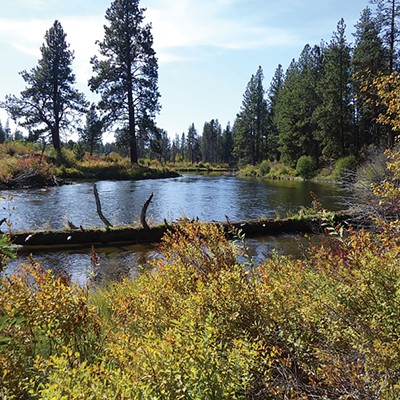It's a cycle that's proved difficult to break. Now, after a bid for a casino in the Columbia Gorge failed (see sidebar), the tribe is exploring a new solution: more gambling closer to home.
Nearly 20 years after The Confederated Tribes of Warm Springs first got into the gaming business at Kah-Nee-Tah, their leaders are looking to double down on casino operations, hoping that black jack tables and slots might help to pave the way for brighter days in Warm Springs, where the new Indian Head Casino is located along Highway 26.
"One of the factors was the desire to jumpstart the economy in Warm Springs and keep some of our money right here," said Deepak Sehgal, chairman of the board of directors of the Warm Springs Casino and Resort Enterprise Board. "This will be a first time where people come (to Warm Springs) and leave some money."
There's just one catch. Moving the casino leaves Kah-Nee-Tah Resort to fend for itself in a windswept series of hills 13 miles away in an area that's as remote as it is breathtaking. It's a tall task. The resort, founded in 1964, will be competing with more modern destinations across Central Oregon. But it's a gamble tribal leaders are willing to make, at least until political winds change and the tribes have another chance at a Columbia Gorge casino.
"This is the start of something different," said Sehgal. "We can't just sit and wait forever on a political decision for the gorge."
CASINO IS A "GOLDEN GOOSE"
The new 24-hour-a-day casino is much larger than its former incarnation as a jumble of slots and tables crammed into a room at the Kah-Nee-Tah lodge. The new building is long, with concrete ramps that resemble the old Celilo Falls fishing platforms jutting into rippled blue siding.
It was designed and built in a year almost to the day after the Warm Springs Tribal Council gave the go ahead. The architecture and design is a not-so-subtle response to all the political forces the tribes feel have cheated them out of opportunities in the past, like the Columbia River fisheries and the chance for the Gorge casino.
"This casino will help replace some of what was taken away," said Ken Billingsley, the general manager of the casino.
Billingsley is a tall Indian who grew up on the Warm Springs reservation but whose own tribe is in the Dakota plains. He wears a braid down his back and a gold hoop in each ear. He gets fired up about how casinos are the one "golden goose" opportunity available to tribes.
"This is the one law that Congress has created for Indian people that is truly working," he said on my tour of the new casino one week after the grand opening on Feb. 4. We spoke in the quiet back office rooms that take up about half the new building. On the casino floor, hundreds of people - many of them using wheelchairs, walkers or canes - pushed cash into the 500 machines.
Outside, the parking lots were mostly full and a ragged plywood sign scrawled with "Casino overflow parking" in black spray paint pointed drivers to the lot across the street at the Warm Springs Museum. The tribes expect that the casino will draw more traffic into the museum and that, along with Kah-Nee-Tah, the reservation will boast three destinations within 20 minutes of one another.
"I think it's going to affect the museum in a really positive way," said Carol Leone, executive director of the Warm Springs Museum. "We have had people over to the museum's gift shop (from the casino) to look at things and ask questions. It will be an attraction."
SIDE BET ON KAH-NEE-TAH NOT A SURE THING
The goal is to offer these three distinct experiences to visitors in the hopes that the trifecta will draw people from all over the state. Tribal leaders say they believe Kah-Nee-Tah may flourish under this approach and are ready to shell out big money to remodel all the resort rooms as they refocus on providing a traditional resort experience without a casino.
"We don't think of this as a negative for Kah-Nee-Tah at all," said Sehgal. "More and more people that go for a resort experience are not the same people that go for the casino experience. The people that come to the casino (want) a cheap room, cheap food and just let me have at the machines. We just want to go back to traditional (resort) things and not cater to the daytripper."
Kah-Nee-Tah is a beautiful lodge with huge views of the surrounding landscape, clean cedar planking throughout and special touches like giant fireplaces and unique, '60s-inspired chandeliers.
The village section of the resort boasts a hot springs-heated swimming pool just a stone's throw from family-friendly teepees for camping. Year-round golf, horseback riding, a water slide and spa are all additional draws.
But sitting in the completely empty resort bar during happy hour on the Saturday before Valentine's Day, it's clear that there's a lot of work needed to make Kah-Nee-Tah viable as a stand alone resort.
The resort is off the beaten path and, without the casino, which was added to the resort in 1995, will have to compete head-on with more modern destination resorts throughout the region.
Several of those resorts, including Pronghorn and Brasada, opened for business within the last five years with luxurious accommodations that are often available at steep discounts to drive traffic at the restaurants and golf courses. Even the older, more established resorts, including Black Butte Ranch and Sunriver Resort, have invested heavily in the past few years to remain competitive.
Even with remodeled rooms - resort management said, next fall, they will gut guest rooms, replace furniture and work with the museum to redecorate - the lodge will still have to get visitors in the door.
"I think the lodge was dependent on the casino traffic for occupancy," said Billingsley, who was the executive director of the tribes' gaming commission for a time when the casino was at Kah-Nee-Tah.
But the casino's new general manager, Carlos Smith, said he is not worried. The tribes will roll out a major marketing campaign in the next months, including development of a new logo. In the end, Smith said Kah-Nee-Tah's list of attractions and proximity to Portland set it apart from other destination resorts in Central Oregon.
TRICKLE DOWN MAY RAISE ALL BOATS
In addition to thinking they will succeed at rebranding Kan-Nee-Tah, the tribe is also willing to uncouple the resort from the casino because gaming revenues on the highway will be so much higher. The tribes expect to make between $9 and $12 million a year at Indian Head. That's three or four times as much as it ever made at Kah-Nee-Tah.
Answers about how the tribes will actually spend the additional casino monies were vague, with sources simply saying it will be up to the tribal council.
Sehgal said the tribes' other revenue streams, like timber and electricity production, have waned in the down economy and they need the additional revenue to run the reservation, just as a city would in a similar situation. The tribes, he explained, are responsible for providing health care, education and other opportunities to their people.
The new casino has directly created about 200 jobs and the remodel of Kah-Nee-Tah will provide a bump to construction laborers, but it's the cash that could go into the hands of new small business owners that may really make a difference in the lives of the people on the reservation.
Right now visitors must head on to Madras or Kah-Nee-Tah for a place to spend the night, and there are no visitor-oriented eating establishments except for the deli and restaurant in the casino. Tribal leaders want to see Warm Springs locals start their own businesses and capture some of the cash casino visitors are prepared to leave behind.
"This is going to boost the economy," said Janell Smith, a tribe member who works in the gift shop at the casino. "The vendors next door are seeing more business, even the grocery stores have."
One of the keys to prosperity in Warm Springs, though, will be that residents see the casino as a way to bring business in, without risking their own money on the tables, said tribal officials.
"We don't want to see those brown faces in here," as one Native American casino employee put it.
That means casino management must walk the delicate, and perhaps controversial, line of encouraging certain clientele and discouraging others.
The same will hold true if the tribal council gains the necessary permits to serve alcohol. Because the reservation is dry, the casino would then become the only place around, besides Kah-Nee-Tah, to sit down at a bar and have a beer or a cocktail.
If small business owners do take advantage of casino trickle-down, and high rates of gambling addiction aren't added to the list of reservation woes, the denial of a casino in the Gorge may, in fact, have been a blessing in disguise.
Dream of a Gorge Casino Deferred
In fall 2010, the hopes of a casino in the gorge were dashed for the Confederated Tribes of Warm Springs. Along with it went expectations of more than $60 million in revenues per year and what tribal leaders felt was a secured future for the tribe.
To those that opposed the casino, including environmental groups and the sitting governor, it was a victory. But the tribes believe it is only a matter of time before the political winds change and an opportunity, once again, arises to move the casino off reservation and within an hour of the state's largest population center.
One trick will be finding a location as good as the port of Cascade Locks. For many years, the tribes had an arrangement with the city of Cascade Locks that would allow them to locate the casino in an industrial port area of the town.
Last January, the city leaders of Cascade Locks chose not to renew that agreement, leaving the casino homeless.
"It's effectively over," said Michael Lang, conservation director with Friends of the Columbia Gorge, the main environmental group that opposed moving a casino into the gorge near a scenic reserve area. "The casino application cannot be approved. Period."
If the tribes want to take another shot at the gorge, they will have to find another willing partner or find a way to develop Warm Springs landholdings into parcels that could sustain a casino and related parking lots and outbuildings. It's something the tribes have an obligation to continue exploring, said tribal officials.
"No casino on the reservation could meet the needs of the tribes into the future," said Sehgal.
But in the meantime, the tribes will make a go of it in Warm Springs and, if tribal members take advantage of new business opportunities offered by all the new visitors, a casino there may invigorate the town currently best known as a place to stop for gas between Central Oregon and Portland. - Erin Foote Marlowe





















